|
|
|
|
|
|
|
News & Views item - September 2006 |
![]() Taking Science to School: Learning and Teaching Science in Grades K-8 --
The National Academies' National Research Council Report. (September 25,
2006)
Taking Science to School: Learning and Teaching Science in Grades K-8 --
The National Academies' National Research Council Report. (September 25,
2006)
A 352 page report, Taking Science to School: Learning and Teaching Science in Grades K-8, to be published next year (ISBN: 0309102057) has been made available online in prepublication form by the National Academies Press (ISBN: 0309103347) and is available to download in PDF format for $US44.
The report's bottom line is summed up in ScienceNow's write-up:
Children are capable of understanding more science than many educators give them credit for. But those same teachers may not know enough to help their students learn what they need to know to compete in a global economy.
And if that sounds familiar it ought to, a comparable criticism has been leveled at the condition of Australia's primary (as well as secondary) science and maths teaching.
Interestingly, through the years when Brendan Nelson was gung-ho in his bashing of Australia's university system and keen to have flagpoles raised in public school yards, serious efforts to improve the inducements for procuring and retaining outstanding maths and science teachers would require a scanning electron microscope to find. And during the eight months of Julie Bishop's incumbency, a diminution of vituperation hasn't been correlated with an increase in effect.
And as might be seen as a variation on the theme the most recent OECD-wide assessment has found Australia's public expenditure on tertiary institutions fell 7% between 1995 and 2002. Only four OECD nations were more negative.
In a radio interview several months back Ms Bishop when challenged about Australia's OECD's report card replied that she had written to the OECD claiming that their analysis was flawed. Of course you might be inclined to believe she would; after all who would be seen to have the "conflict of interest" in doing the calculation.

The executive summary of the National Academies' report opens with:
At no time in history has improving science education been more important than it is today. Major policy debates about such topics as cloning, the potential of alternative fuels, and the use of biometric information to fight terrorism require a scientifically informed citizenry as never before in the nation’s history. Yet after 15 years of focused standards-based reform, improvements in U.S. science education are modest at best, and comparisons show that U.S. students fare poorly in comparison with students in other countries.
The charge to this committee was to answer three broad questions: (1) How is science learned, and are there critical stages in children’s development of scientific concepts? (2) How should science be taught in K-8 classrooms? (3) What research is needed to increase understanding about how students learn science?
To the writers of the report it is axiomatic that students who are proficient in science:
1. know, use, and interpret scientific explanations of the natural world;
2. generate and evaluate scientific evidence and explanations;
3. understand the nature and development of scientific knowledge; and
4. participate productively in scientific practices and discourse.
Blow is listed the essence of the committee's eight recommendations. A conceptual umbrella is the view that science must be seen to be both the knowledge gained and the scientific method used to gain that knowledge. The tendency over the past several years to present science as a dichotomy is a false and counterproductive one.
Recommendation 1: Developers of standards, curriculum, and assessment should revise their frameworks to reflect new models of children’s thinking and take better advantage of children’s capabilities.
Currently, standards and many widely used curriculum materials fail to reflect what is now known about children’s thinking, particularly the cognitive capabilities of younger children.
Recommendation 2: The next generation of standards and curricula at both the national and state levels should be structured to identify a few core ideas in a discipline and elaborate how those ideas can be cumulatively developed over grades K-8.
Recommendation 3: Developers of curricula and standards should present science as a process of building theories and models using evidence, checking them for internal consistency and coherence, and testing them empirically. Discussions of scientific methodology should be introduced in the context of pursuing specific questions and issues rather than as templates or invariant recipes.
Recommendation 4: Science instruction should provide opportunities for students to engage in all four strands of science proficiency.
Recommendation 5: State and local leaders in science education should provide teachers with models of classroom instruction that provide opportunities for interaction in the classroom, where students carry out investigations and talk and write about their observations of phenomena, their emerging understanding of scientific ideas, and ways to test them.
Recommendation 6: State and local school systems should ensure that all K-8 teachers experience sustained science-specific professional development in preparation and while in service. Professional development should be rooted in the science that teachers teach and should include opportunities to learn about science, about current research on how children learn science, and about how to teach science.
Recommendation 7: University-based science courses for teacher candidates and teachers’ ongoing opportunities to learn science in service should mirror the opportunities they will need to provide for their students, that is, incorporating practices in the four strands that constitute science proficiency and giving sustained attention to the core ideas in the discipline. The topics of study should be aligned with central topics in the K-8 curriculum.
Recommendation 8: Federal agencies that support professional development should require that the programs they fund incorporate models of instruction that combine the four strands of science proficiency, focus on core ideas in science, and enhance teachers’ science content knowledge, knowledge of how students learn science, and knowledge of how to teach science.